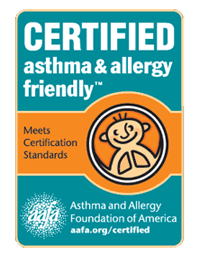If you're reading this, there's a good chance you're one of the millions of Americans with a dust mite allergy. But how well do you know these microscopic creatures? Let's look at some common misconceptions about dust mites and dust mite allergy.
Myth #1: Dust mites are found in dust.
Fact: Dust in your home is mostly made up of human debris (skin cells, hair and “other”). It also contains dirt, pollen, mold spores, microplastics and fibers. If you have animals in your home, it will contain a larger amount of animal dander as well. (All homes have animal dander even if they don’t have pets.) Sometimes dust mites are found in dust. But they don’t live there for long, especially if the dust is on a hard surface.
To live, dust mites need moisture and to feed on human skin cells. They thrive in humid locations like your bed (you sweat and breathe, trapping humidity under your covers). They are also found in your fabric furniture (couches, chairs) and carpet. They are sometimes found in your curtains. They like stuffed animals, especially those allowed on the bed. Dust mites thrive in these areas because these are not normal places you clean for dust.
Myth #2: Dust mites are only found in the Southeast United States because it's more humid.
Fact: To prevent dust mites, you have to reduce humidity or block their access to human skin. Some dry, high elevation places have low concentrations of dust mites, such as Colorado, but everywhere in the U.S. has dust mites.
Myth #3: Dusting is the best way to get rid of dust mites.
Fact: There are two ways to prevent exposure to dust mites:
- Reduce humidity
- Block access to human skin cells (barrier)
CERTIFIED asthma & allergy friendly® allergen-barrier mattress or pillow covers prevent dust mite colonies from booming in your bed. They will still live in your sheets, pillowcases and blankets, but with regular washing with hot water, you can keep the numbers down.
Myth #4: People with asthma don’t have to worry about dust mites.
Fact: Dust mites are a concern for people with dust mite allergy. And many people with dust mite allergy also have eczema and asthma that is triggered by dust mites.
But dust mites are also a problem people with asthma even if they aren't allergic to dust mites. The dust mite debris (dead bodies, fecal matter) they create is considered an irritant that worsens indoor air pollution. The dust mite debris is then inhaled and is an irritant to inflamed lungs.
Myth #5: Since dust mites are microscopic, they don't affect indoor air quality.
Fact: If you want to improve your indoor air quality, dust mite containment and prevention is a key step. Dust mite debris can become airborne, affecting indoor air quality.
Now that we've debunked some common myths about dust mites, what's next? These tiny creatures are everywhere, so is possible to keep them under control?
There's good news. If you are allergic to dust mites, there are ways you can manage them to keep your symptoms under control:
- Use CERTIFIED asthma & allergy friendly® allergen-barrier mattress or pillow covers
- Wash bedding in water that's at least 130 F weekly
- Keep the humidity in your home below 50%
- Get rid of fabric items you cannot wash regularly (carpeting, curtains, upholstered furniture, etc.), if possible
- Talk to a board-certified allergist about allergy testing and long-term allergy treatment
- Use other CERTIFIED asthma & allergy friendly® products to create a healthier home environment, such as air filters and vacuum cleaners

Visit aafa.org/certified to search for CERTIFIED products. There you can also learn more about the asthma & allergy friendly® Certification Program.

Comments (7)